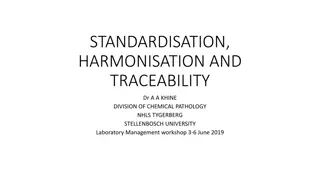Dairy Laboratory Setup and Quality Control Guidelines
This article discusses the setup of testing facilities and analytical laboratories in the dairy industry, including the concept of mobile testing laboratories. It covers the types of dairy laboratories based on milk production, the importance of QC lab location in a dairy, layout and design considerations, general requirements for a QC lab, and specifications for walls, windows, lighting, flooring, storage rooms, benches, and cupboards. The guide provides detailed insights into creating a functional dairy laboratory for quality assurance.
Download Presentation

Please find below an Image/Link to download the presentation.
The content on the website is provided AS IS for your information and personal use only. It may not be sold, licensed, or shared on other websites without obtaining consent from the author. Download presentation by click this link. If you encounter any issues during the download, it is possible that the publisher has removed the file from their server.
E N D
Presentation Transcript
SETTING UP OF TESTING FACILITIES AND ANALYTICAL LABORATORIES, CONCEPT OF MOBILE TESTING LABORATORIES
Types of dairy laboratories (According to BIS 5 types) : 1) Category A - 1 lakh liters or more of milk per day. 2) Category B - 25,000 litres or more of milk per day, but less than 1 lakh litres. 3) Category C - 10,000 liters of milk or more per day, but less than 25,000 liters. 4) Category D - 5,000 liters of milk or more per day, but less than 10,000 liters. 5) Category E - less than 5,000 liters per day.
Location of QC lab in a dairy: should not be at a remote place from the dairy operations. should not be very close to the dairy operations where there can be lot of noise, vibrations, steam etc. should preferably be away from boiler houses. should be easily accessible for all the major activities of the dairy.
Layout / design of the laboratory: adequate number of rooms/chambers and benches etc of suitable dimensions. possible expansion of the dairy should be kept in view. minimum of 2 exits. BIS has given two alternate layout plans.
General requirements for a QC lab : 1) Walls - smoothly finished - glazed tiles - wash up room and platform - Gerber test is conducted. 2) Windows - sufficient number - glass panes - to receive adequate natural light. 3) Lighting i) Natural day light. ii) Northern or east - northern - exposure is preferred - color matching. iii) Lights - minimum average intensity of 400 to 450 lumen/m2 at working level. iv) Direct sun light should be avoided - sensitive instruments (e.g. Chemical balance) v) Roof light - helpful.
4) Flooring - non- slippery and cleaned easily. 5) Store room - two : 1. acids, alkalies , ammonia 2. fine chemicals, glassware, apparatus and equipment. 6) Benches - several designs/sizes - examples : (i) 150 x 75 x 90 cm (ii) 220 x 75 x 90 cm (iii) 360 x 67.5 x 90 cm (iv) 150 x 75 x 75 cm (v) 210 x 75 x 75 cm Any convenient size can be used.
Bench top - resistant to acid and alkali A. Above bench fittings - Shelves keep various solutions, chemicals, reagent bottles, glassware etc. B. Under Bench fittings - Drawers and cupboard with shelf accommodation could be of fixed or removable type and inter changeable. 7) Cupboards - adequate number. wall cupboards preferred provide space for storing without occupying the floor space.
8) Sinks A. suitable dimensions in wash-up rooms glazed earthenware or vitreous ware or stainless steel. Preferable dimensions 75 x 45 x 25 cm. B. Service bench or laboratory bench or working bench should be fitted beneath the bench top porcelain or other suitable material Dimensions are 45 x 30 x 20 cm. 9) Fume cupboard/ fume hood/fume chamber - efficient means of removing objectionable fumes, gases, vapors etc for carrying out operations which cause fumes etc. Fume chambers should have the provision for gas, water, waste outlet and electricity.
Fume hood 10) Water supply - There should be adequate water supply. 11) Distilled water plant - of adequate capacity should be available in each lab .
(a) Metal Distillation Assembly (b) Glass Distillation Assembly (c) Quartz Distillation Assembly
12) Gas - provision of gas supply in the form of own gas supply, in the form of own gas plant or portable gas supply. 13) Electric supply - electric supply, electric points for water bath, heaters, oven etc. 14) Service lines (of water, gas & electric power) - tap water, electric power and gas, should run along the walls, concealed 80 cm above floor level and connection taken to the laboratory benches. While installing service lines, two main points should be kept in mind: a. Benches should be easily removable. b. Service lines should be easily accessible.
15) Drainage 16) Fire-extinguishers 17) Ventilation 18) Air-Conditioners 19) Chemicals, glassware & Consumable Stores 20) Equipments
List of equipments ordinarily required in QC lab Mojonnier apparatus, water baths Hot air oven, Hot plates Analytical balances, Desiccators Colorimeter / Spectrophotometer Nitrogen digestion / distillation apparatus
Glass distillation apparatus Refrigerator, BOD incubator Microscope, Autoclaves Milko tester / Milko scan Gerber fat testing centrifuge Automatic measure for Gerber acid and iso - amyl alcohol
Butyro - refractometer with circulating water bath Polarimeter pH meter, Viscometer Pro-milk, Infra-red Moisture tester General purpose centrifuge Solubility index apparatus
Special Requirements for specific purposes 1. Fat Test white tiled platform of suitable dimension 2. Wash-up Room 3 sink units with draining board & draining rack. 3. Balance Room least affected by vibrations. 4. Doors self closing.
5. Bacteriological Room dust-free and air- conditioned. 6. Drains made of an acid-proof material. the volume of discharge should be taken into account. should be provided with suitable traps at suitable places to prevent blockage of drains. 7. rooms meant for analytical work in the laboratory should be fly- proof and rodent proof.
Various chemical tests ordinarily conducted in a dairy laboratory 1.Organoleptic test 2.Sediment test 3.Alcohol test 4.COB test 5.Acidity 6.Fat 7.SNF 8.Freezing point determination 9.Adulterants 10.Preservatives
11. Neutralizers 12. Phosphatase test 13. Hardness of water 14. Available chlorine (Cl2) 15. pH 16. Turbidity test 17. Salt (NaCl) purity 18. BR at 40 C 19. Reichert Meissl value (RM) and Polenske value (PV) 20. Acid value 21. Sugar / lactose 22. Over-run (weight per liter) 23. Strength of alkali / acid etc.
Mobile Testing Laboratories integrated analytical platform equipped with state-of the art measurement systems - to detect, analyze and confirm the chemical and biological adulterants/contaminants in food, water, milk etc. Lab for the detection of food adulteration - rapid chemical and microbiological tests in particular - should have proper safety features - fabricated on a specially modified mobile platform like heavy duty trucks. FSSAI setup the mobile testing laboratories - expected to be positioned at various locations in the country.
Objectives of Mobile Testing Laboratory To take food testing - door steps of the consumers and others. i) Visit the local markets, households, restaurants, godowns, schools and other public places, conduct tests on the spot and declare the result thereby creating awareness among people and also furnish feedback to the food safety authorities. ii) Collection of information by means of testing and preparation of a data base, useful in maintaining surveillance and could also be utilized by the Food Safety Officers, Laboratories and others involved in Food Safety regulation.
Design of the Laboratory laminated panels with excellent insulation properties. External dimensions - type and kind of testing to be carried out in a particular laboratory. Container is designed in such a manner that it can be lifted by both crane, truck with container hoist and can be transported by truck, ship, train and aeroplane. Laboratory two portions internally by a sliding door.
One half of the laboratory - the preparation of samples and the other functions measurement laboratory where instrumentation can be located. platform includes both rear and side entry doors with dual pan windows. adequate number of generators most likely two numbers one on each side of the platform. filtered fresh air intakes and exhaust vents with HEPA (High Efficiency Particulate Air) filters to avoid contamination of environment.
A basic mobile laboratory should have the following features: 1. Mobile laboratory At least 20 ft. container laminated aluminium panels. Ext. dimensions: 606 x 244 x 244 cm. i) connection to external power supply (230 - 400 V). ii)connection to external water supplies, air conditioning and internal climate control for operation in adverse weather conditions. iii)Separate air conditioning and ventilation systems. iv)Built in diesel generator for power supply in the event of power cuts. v)Fume hood, refrigerator/freezer/microwave. vi)Lines for telephony, data, internet, e-mail.
equipment Equipments
2. Equipment Type of equipment depends upon kind of testing to be performed. The possible equipments : i) Sampling equipment and containers. ii) Milko tester/Milk analyzer iii) Ovens, Incubators. iv) Gerber Centrifuge and clinical centrifuge. v) Rapid chemical testing kit. vi) Rapid microbiological testing kits vii) Biosensor based tests for antibiotics etc. viii) Lactometers, ix) Computers (PC s), Printer x) Protective equipment























